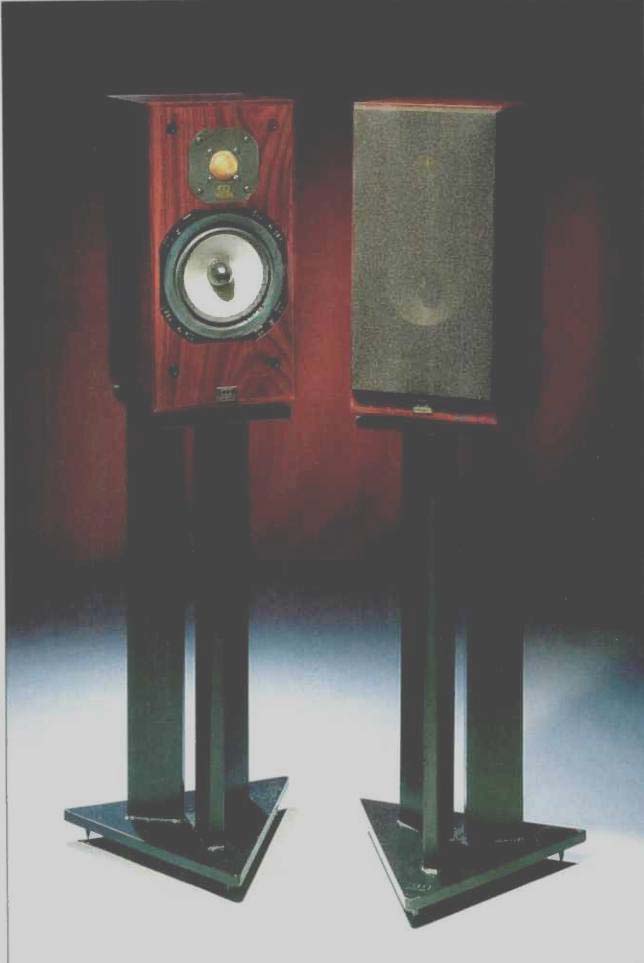
Manufacturer's Specifications:
System Type: Two-way, vented, stand-mounted system.
Drivers: 6 1/2-in. (16.5-cm) metal-cone woofer and 1-in. (2.54-cm) metal dome tweeter.
Frequency Response: 40 Hz to 20 kHz, ±3 dB. Sensitivity: 88.5 dB SPL for 1 watt input at 1 meter.
Maximum Output: 120 dB SPL.
Crossover Frequency: 3.4 kHz, 6dB/octave slope.
Impedance: 8 ohms nominal.
Recommended Amplifier Power: 20 to 200 watts per channel.
Dimensions: 15 3/4 in. H x 7 7/8 in. W x 9 1/8 in. D (40 cm x 20 cm x 25 cm).
Weight: 17 lbs. (7.7 kg) for single speaker.
Price: $3,000 per pair, not including stands.
Available in Santos rosewood, California oak, black ash, and American walnut. ST-10 lead-filled metal stands, weight: 66 lbs. (30 kg) each, $850 per pair.
Company Address: P.O. Box 1355, Buffalo, N.Y. 14205.
The Studio 10 is Monitor Audio's entry in the field of expensive two-way monitors. The system embodies the results of some of the latest materials and manufacturing research, as evidenced by its use of not only a metal-dome tweeter but also a one-piece metal-cone woofer. All Monitor Audio systems are supplied with premium real-wood veneered cabinets, manufactured by Monitor Audio itself. The review samples were supplied with a pair of massive metal stands that are almost four times heavier than the speakers themselves.
Monitor Audio was the first British speaker company to offer metal-dome tweeters, in 1984. The Studio 10's tweeter is unique in that its dome is made of an aluminum/magnesium (88%/12%) alloy with a gold-colored anodized finish.
The anodizing greatly increases stiffness, which raises the first breakup mode above the audible range. The tweeter's voice-coil former is vented and cooled with Ferrofluid to minimize temperature increases.
The 6 1/2-inch woofer uses an aluminum-alloy cone, which is drawn in three stress-relieved steps into a complete one-piece cone and voice-coil former assembly. The heat generated by the voice-coil is conducted through the coil former to the metal cone itself, for improved dissipation. The cone is 100 µm (0.004 inch) thick and is sandwiched between two anodized ceramic damping coatings, 50 µm thick, making a total cone thickness of 200 um. The cone is also crimped over along its circumference for increased stiffness. The woofer's unique cone materials and construction raise the cone's first breakup mode above 6 kHz, above its operating band. The woofer, which has a vented-pole magnet, is also built with a heavy, 10-mm thick die-cast frame which strengthens the assembly and helps to maintain close production tolerances.
Monitor Audio was founded in 1972 by Molqbal, a Kenyan of Indian descent who studied electrical engineering at Cambridge University. The company is now one of the most vertically integrated speaker companies in the U.K., manufacturing its own drivers, crossovers, and cabinets, and producing cabinets for other British speaker manufacturers. Instead of following standard production-line methods, Monitor lets each worker build a complete product from start to finish. With only one worker per assembled product, there is no one else to blame if something is incorrect or goes wrong! Monitor Audio's philosophy is that simpler is better when it comes to system and crossover design; their whole line contains only two-way systems. The company feels that this configuration allows more money to be put into developing and manufacturing each driver and the crossover, and that less complex systems allow greater fidelity to be achieved.
The crossover, a relatively simple design, has only six components, equally distributed among resistors, capacitors, and inductors. The slope of the crossover is stated to be 6 dB per octave. The system has two pairs of five-way binding posts on the rear, connected with short lengths of bus wire which may be removed for bi-wiring. Monitor Audio states that the unique design of their drivers allows a simpler crossover because their responses are much smoother and better controlled, both within and outside of their operating bands.
The enclosures are very well built of 3/4-inch Medite medium-density fiberboard. They are finished on the front and four sides, while the backs are black. The four sides of each cabinet are produced from one veneered plank of fiberboard so that all the sides match perfectly. The evaluation systems were supplied in a gorgeous, very well matched rosewood. Both outside and inside surfaces of the cabinet are veneered with real wood. (Now if I only could figure out how to turn the cabinet inside out because of a scratch on the outside!) The enclosure, which Monitor Audio calls a Single Flow Reflex, is a vented box (bass reflex), tuned by a tube 3 1/2 inches long with a 2-inch inner diameter, at the top rear of the cabinet.
Measurements
The on-axis frequency response curve, for a 2.83-V rms input, is shown in Fig. 1. A tenth-octave smoothing filter was used. The curve was actually taken at a distance of 2 meters, 12 inches up from the bottom of the box, normal to the enclosure's front surface but is referenced to a 1-meter distance. With the grille on, the response was minimally affected, less than ± 1.5 dB or so. All the following measurements were taken with the grille off.
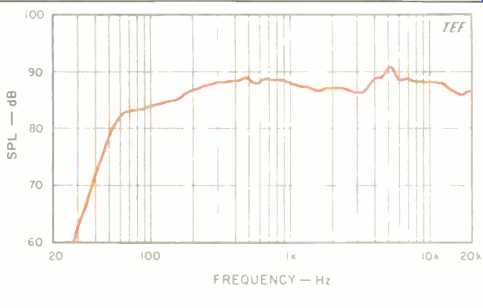
Fig. 1--One meter, on axis anechoic frequency response, measured with grille
off, for an input of 1 watt into 8 ohms (2.83 V
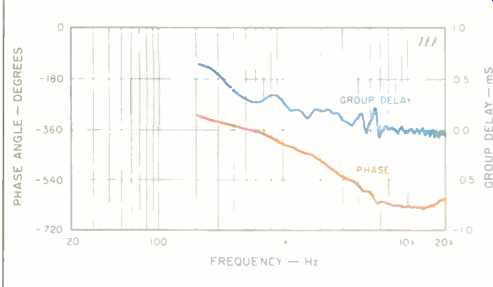
Fig. 2--On-axis phase response and group delay, corrected for tweeter arrival
time.
Excluding the slight peak at 5.1 kHz, the curve fits within a ±3.0 dB window from 60 Hz to 20 kHz. Even with the peak, the curve fits within a much tighter ±2 dB envelope from 180 Hz to 20 kHz. The response droops below 300 Hz and then falls quite rapidly (at 24 dB/octave, typical of vented boxes) below 60 Hz. Averaging the axial response over the range of 250 Hz to 4 kHz yielded a sensitivity of 87.7 dB, only slightly lower than the manufacturer's rating of 88.5 dB. The systems were matched quite closely, within ± 1 dB above 100 Hz. A higher 30-kHz measurement revealed a high-Q dome breakup resonance at 25.8 kHz, which stuck up about 15 dB above the average level of the system. Most metal-dome tweeters exhibit such resonances, but fortunately the Studio 10's tweeter resonance has been raised way above the audible range and should not be a performance detriment.
The axial phase and group-delay measurements of the system, corrected for the tweeter's time arrival, are shown in Fig. 2. The phase response exhibits a total phase rotation of only about 220° between 1 and 20 kHz. The group-delay curve is fairly well behaved above 1 kHz, and shows that the midrange lags the tweeter. A separate measurement of offset indicated that the midrange does indeed trail the tweeter by about 0.11 mS (110 µS), which corresponds to a distance of 1 1/2 inches (38 mm). This is about one-third wavelength, about 120°, at the measured 3.0-kHz crossover.
The energy-time curve (ETC) is shown in Fig. 3. For it, a test signal is swept from 200 Hz to 10 kHz at an equivalent of 2.83 V rms at 1 meter on axis. The main arrival, at 3 mS, is quite compact and well behaved, but the overall response exhibits some broadening at lower levels. (Under these test conditions, a perfect energy-time curve would appear as a single sharp spike centered at 3 mS, with a width of about 1 mS at the base, the 50-dB line, and tapering to a rounded point at the top.) All the inside surfaces of the cabinet are covered with inch-thick foam to damp internal standing waves and reflections. The sides also have an inert black damping pad, 1/4 inch thick, attached to their surfaces to reduce wall resonances. In addition, as the company literature stated, all the inside surfaces are veneered, but not finished, and the veneer is not rosewood.
A high-level low-frequency sine-wave sweep revealed that the cabinet sides and back resonated slightly at about 445 Hz but were otherwise quite rigid. Fairly significant wind noise was generated from the port (from the inside opening, not its tapered outside edge) at levels above 5 V rms (3 watts) at frequencies from 45 to 85 Hz. The woofer's excursion reached a strong minimum at the 60-Hz box tuning, which indicated that the vented enclosure was working very well. Below 60 Hz, where the vented box unloads, the woofer's excursion increased very significantly, accompanied by high distortion. The woofer exhibited some dynamic offset when the impedance fell as frequency increased.
The horizontal off-axis curves of the Studio 10 are shown in Fig. 4. These normalized curves are quite well behaved within ± 20° of the axis and exhibit some roughness above 3 kHz at angles beyond 20°. The vertical off-axis curves, shown in Fig. 5, are also quite well behaved except for off axis peaks and dips in the crossover region. The curves indicate reasonably symmetrical up/down behavior, showing that the driver's acoustic responses are mostly in phase with each other through the crossover region, thus minimizing lobing error.
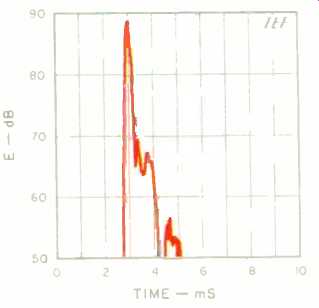
Fig. 3--One-meter on-axis energy/time curve, measured with grille off. The
main weak is well behaved, but some broadening is evident at lower levels.
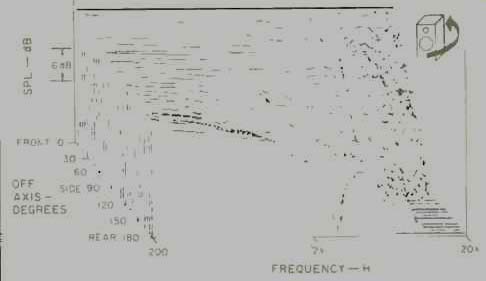
Fig. 4--Horizontal off-axis frequency responses, taken from the front, around
the side, to the rear of the speaker and normalized to the on-axis response.
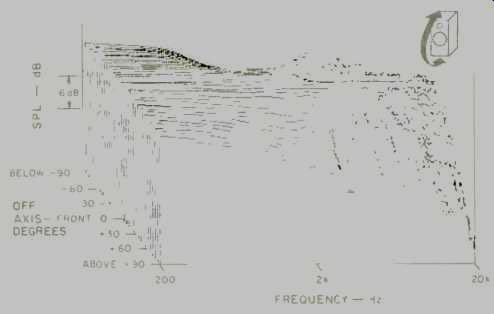
Fig. 5--Vertical off-axis responses taken from below, up the front, and
to the top of the speaker and normalized to the on-axis response.
The six crossover parts are wired point to point and attached by hot-melt glue to the input-terminal panel, which is a piece of 1/2-inch particleboard. Notwithstanding the 6 dB/octave claimed, both high- and low-pass portions of the crossover are of second-order, 12-dB/octave electrical design. The specific configuration of the low-pass network for the woofer side can be considered either a second-order low-pass or a first-order low-pass with an impedance-compensating "Zobel" network. Response measurements of driver voltage confirmed that the network indeed provides 12-dB/octave roll-offs, at least at points beyond the crossover range. However, this is not the whole story; the actual crossover response consists of the cascaded combination of both the network's and the drivers' responses. Measurements of each driver's acoustical response when connected to the crossover revealed that the response within ± 0.5 octave of the crossover frequency is about 6 dB/octave, becoming 12 dB/octave thereafter. Nonetheless, the drivers actually measured somewhat in phase with each other through the crossover region, rather than 90° out of phase, as expected from the 6-dB/octave slope. This explains the minimal lobing error.
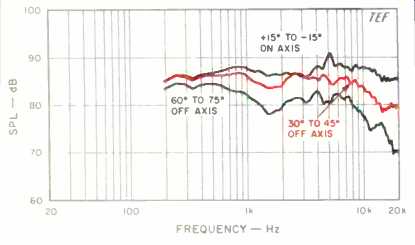
Fig. 6-Mean horizontal response, derived from data of Fig. 4.
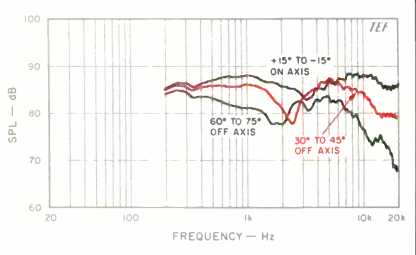
Fig. 7-Mean vertical response, derived from data of Fig. 5.
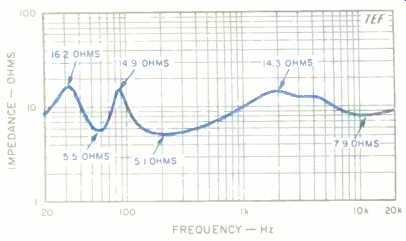
Fig. 8-Impedance; note the logarithmic impedance scale.
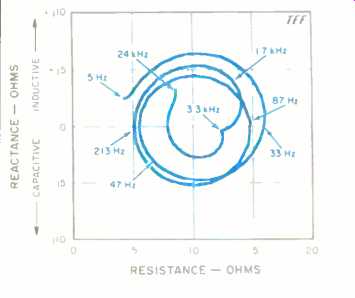
Fig. 9-Complex impedance, showing reactance and resistance vs. frequency.
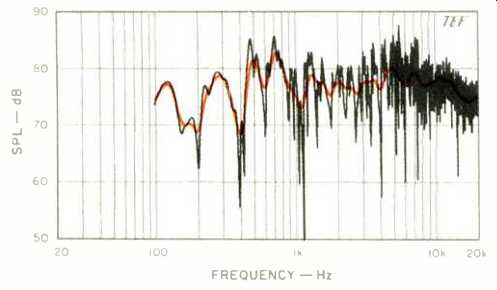
Fig. 10--Three-meter room response, showing both raw and smoothed data; see
text.
The NRC-style mean horizontal and vertical on- and off-axis response curves of the Studio 10 are shown in Figs. 6 and 7, respectively. The horizontal curve in Fig. 6 is quite smooth and extended except for the narrow peak at 5.1 kHz. The 30° to 45° response is fairly well behaved and extended but exhibits high-frequency roll-off above 10 kHz.
The 60° to 75° off-axis averaged response exhibits a plateau of sorts above 1.5 kHz, and its roll-off, which begins at 6 kHz, becomes steeper above 10 kHz.
The vertical response of the Studio 10s is shown in Fig. 7. The axial curve exhibits a shallow dip in the crossover region at 3 kHz, which also shows up to a greater degree in the two remaining off-axis mean curves. The off-axis curves both roll off above 5 or 6 kHz.
Figure 8 shows the Studio 10's impedance from 20 Hz to 20 kHz. The system has a low of 5.1 ohms at 200 Hz and a high of 16.2 ohms at 31 Hz, which makes it a fairly easy load for most amplifiers. The characteristic double-humped impedance response of vented enclosures is evident between 20 and 150 Hz. The dip at 60 Hz indicates strong loading at the Helmholtz box resonance. At this frequency, most of the sound is radiated by the port, with minimal output from the woofer. The system's minimum impedance of 5.1 ohms, coupled with its variation of only 3.2 x from minimum to maximum, makes the Studio 10 somewhat sensitive to cable resistance. To keep cable-drop effects from causing peaks and dips in response of more than 0.1 dB, cable series resistance must be limited to a maximum of 0.087 ohm (87 milliohms). Figure 9 shows the well-behaved complex impedance (Nyquist) plot from 5 Hz to 24 kHz. The phase angle reached a maximum of + 40° at 20 Hz and a minimum of 39° at 105 Hz.
Figure 10 shows the 3-meter room curve of the system, with both raw and sixth-octave smoothed responses. The Studio 10 was in the right-hand stereo position, mounted on its stand, and aimed at the listening location, and the test microphone was placed at ear height (36 inches) at the listener's position on the sofa. The system was swept from 100 Hz to 20 kHz with a 2.83-V rms sine-wave signal (corresponding to 1 watt into the rated 8-ohm load). The parameters of the TDS sweep were chosen so that the direct sound plus 13 mS of room reverberation were included. The curve is reasonably well behaved and extended except for response roughness below 1 kHz, and most of this was caused by room effects. Above 1.5 kHz, the curve is satisfactorily smooth, with just a small amount of roll-off above 10 kHz.
Figures 11, 12, and 13 show harmonic distortion versus power at the musical notes B1 (61.7 Hz), A2 (110 Hz), and A4 (440 Hz). These measurements indicate the level of harmonic distortion generated with the application of a single frequency sine wave at power levels from 0.05 to 50 watts (-13 to 17 dBW, a 30-dB dynamic range) in steps of 1 dB. The power levels were computed using the rated system impedance of 8 ohms (20 V rms = 50 watts, etc.). Actual power levels are somewhat higher because the impedances at each tested frequency are somewhat lower than the rated impedance.
Figure 11 shows the B1 (61.7-Hz) harmonic distortion data. The higher tone B1 was used, rather than the customary lower E1 (41.2 Hz), because E1 is below the passband of the system and essentially provides no woofer loading because the frequency is about 2/3 of an octave below the 60 Hz box tuning. In a preliminary 41.2-Hz test, 100% second harmonic distortion was reached at a level of only 15 watts! Inasmuch as B1 is close to the Studio 10's box tuning frequency, the distortion at 50 watts is a relatively low 12% second and 5% third, with the higher harmonics significantly below 1% (the test's frequency scale only goes up to the fourth harmonic). At 50 watts, the system generated a fairly loud 99 dB SPL at 1 meter at 61.7 Hz.
The A2 (110-Hz) harmonic data in Fig. 12 show that only the second and third harmonics are significant over the tested range, with the second harmonic predominating. The second harmonic reaches a moderately high level of about 10% at full power, where the third harmonic reaches 6%. Levels of higher harmonics are very low. At 110 Hz, the system generated about 101 dB SPL at 1 meter for 50 watts.
The A4 (440-Hz) harmonic measurements, shown in Fig. 13, are quite low except for some unexplained third harmonic (reaching about 1.5%) at lower power levels.
The IM on a 440-Hz (A4) tone created by lower frequency tones of equal input power level is shown in Fig. 14. Note that when 41.2 Hz (E1) is used as the modulating tone, IM distortion reaches 75% at full power! Clearly, E1 is below the passband of the system. In contrast, with the higher B1 tone, the distortion is more reasonable, about 15%, at full power.
The high IM distortion at low frequencies indicates the system is quite susceptible to being overdriven by high-level program material.
Figure 15 shows the short-term, peak-power input and output capabilities of the system, versus frequency, measured with a third-octave bandwidth tone burst. The peak input power was calculated by assuming that the measured peak voltage was applied across the rated 8-ohm impedance. The maximum input power is shown in the lower curve. At 30 Hz and below, peak power must be limited to only about 2 watts to prevent excessive distortion and inter modulation. Above 30 Hz, the input power rises rapidly up to about 400 waits at the 60-Hz box resonance. A plateau is maintained until about 160 Hz, after which the power rises gradually until it reaches the amplifier's clipping point, about 5 kW at frequencies above 1.5 kHz!
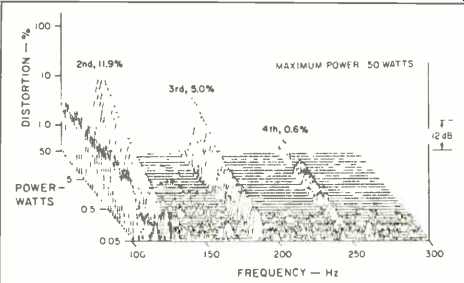
Fig. 11--Harmonic distortion products for the musical tone B1 (61.7 Hz).
Note the change from our customary E1 (41.2-Hz) tone, which is below the
system's passband; see text.
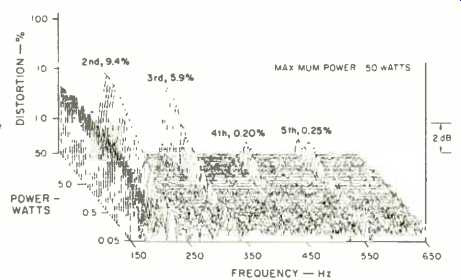
Fig. 12--Harmonic distortion products for the musical tone A2 (110 Hz).
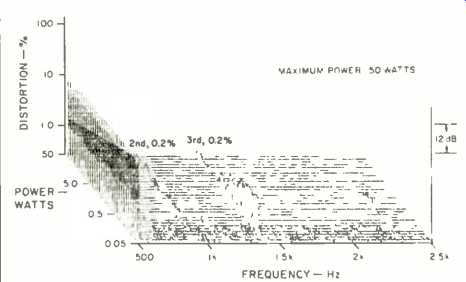
Fig. 13--Harmonic distortion products for the musical tone A4 (440 Hz). Some
third-harmonic distortion is evident at lower power levels; see text.
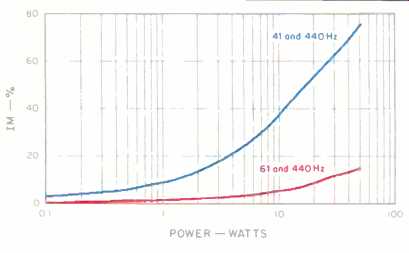
Fig. 14--IM distortion on 440 Hz (A4) produced by 41.2 Hz (E1, upper curve)
and 61.7 Hz (B1, lower curve), when mixed in one-to-one proportion.
The distortion is excessive with the customary lower frequency modulating tone, but it reaches a more reasonable 15% or so IM at 50 watts with the higher B1 tone; see text.
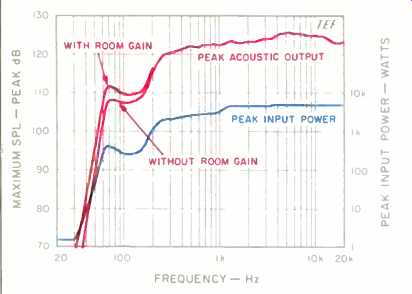
Fig. 15--Maximum peak input power and maximum peak sound output vs. frequency
at 1 meter on axis. Above 250 Hz, the system can generate substantial peaks
in excess of 120 dB SPL; see text.
The upper curve in Fig. 15 shows the maximum peak sound pressure levels the system generates at a distance of 1 meter on axis for the levels shown in the lower curve. Also shown in the upper curve is the "room gain" of a typical listening room at low frequencies. This adds about 3 dB to the response at 80 Hz and 9 dB at 20 Hz. The peak acoustic output rises very rapidly with frequency up to 60 Hz, where a plateau of about 110 dB is reached. Above 160 Hz, the maximum output rises to above 120 dB at frequencies above 300 Hz. With room gain, a single Studio 10 can generate peaks in excess of 110 dB SPL above 60 Hz and greater than 120 dB above 250 Hz. Below 60 Hz, the low frequency output rolls off very rapidly at a rate approaching 48 dB/octave, thus making the low-bass output essentially unusable. A pair of these systems operating with mono bass will be able to generate bass levels 3 to 6 dB higher, particularly if set up near wall boundaries.
Use and Listening Tests
The Studio 10s spent some informal listening time in my office before being moved into the larger listening room.
Here they were hooked up to a Vector Research VRX-3600R receiver and a mid-1980s Kenwood DP-1100B CD player.
Even with this equipment, decidedly not high end, they made a very good account of themselves, wringing out all the good that existed in the supplied signal along with exposing some of the bad. The Studio 10s are suited to smaller listening environments because of their small size and limited low-bass capability.
After setting up the 10s in my larger listening room and driving them with my standard equipment, they really took on a life of their own. Driving equipment included the usual Onkyo Grand Integra DX-G10 and Rotel RCD-855 CD players, along with some new amplification gear: The Jeff Rowland Consummate preamplifier (a bona fide high-end preamp with full remote-control capabilities) and two Jeff Rowland Model 7 monoblock power amplifiers. Also used was the new Crown Macro Reference power amplifier (I must point out up front that I am a paid consultant to Crown). The Krell KSP-7B preamp and Krell KSA-200B power amplifier performed flawlessly and with much distinction during the period I had them. Hookup was with Straight Wire Maestro interconnects and speaker cables. As usual, I did most of the listening before the measurements.
Most of my serous listening was done with the Studio 10s placed on their stands in my accustomed evaluation position, about 6 feet away from the short rear wall, separated by 8 feet, and about 4 feet from each side wall. Most listening was done with the systems canted in and aimed at my head. I listened sitting on the sofa about 10 feet away, which placed my ears about 36 inches above the floor.
The systems were hooked up in a normal single-cable, rather than bi-wired, configuration. The input terminals of the Studio 10 are on the bottom rear of the cabinet and are composed of two sets of five-way binding posts on 3/4-inch centers separated by about 2 inches. (We're not talking about the heavy-duty posts you tighten with a nut driver, but the hand-tightened kind with a small hole for the wire.) You can't plug your standard 3/4-inch-spaced double-banana plugs into these terminals because the posts spaced 3/4 inch apart are actually for the same polarity. Their small holes are mostly filled with the 22-gauge jumper wires connecting the high- and low-pass sections, leaving essentially no room for the cables from the amp. Spade lugs can be used, but they still have to share space with the bus wires.
These are definitely not the well-thought-out connectors you should find on a $3,000 pair of speakers.
The Studio 10s sounded very similar to my B & W 801 Matrix Series 2 systems, except that the low bass was missing and some high-frequency emphasis was evident. In addition, the sensitivities of the different systems were essentially the same. Their soundstaging and imaging were first-rate, and they exhibited a very revealing character.
On the analog-recorded CD The Choir of Grace Cathedral, San Francisco (Wilson Audiophile WCD-794/805), another great CD for organ buffs who also happen to like religious music, the Monitor Audios exhibited a slightly more open and forward sound than the B & Ws on the choral tracks, but with diminished low bass. The high-frequency emphasis of the Studio 10s was evident on the tape hiss between tracks. On track 11, between 6:46 and 6:50, there was severe intermodulation of the choir voices by the organ pedal notes at moderate to loud levels. It is clear that not only is the system's low-bass output reduced, but its low frequency power handling is low as well. A very steep, 50 Hz high-pass filter would be very beneficial to a system that includes Studio 10s. This would greatly reduce IM distortion and dramatically increase the levels at which the 10s can play material with appreciable bass below 50 Hz. A good subwoofer and associated crossover would also be very appropriate for use with the Studio 10s.
The Studio 10s' rendering of the lute solos on O Mistress Mine, A Collection of English Lute Songs (Dorian CD DOR90136) was done with much detail and expressiveness. The crisp plucked-string sound and the reverberant decay of the room were delivered very smoothly, with much realism. I actually preferred the Studio 10s' reproduction of the tenor voice on this CD to my reference systems'. The jazz string bass line on track 1 of the Denon High End Hi-Fi Recordings CD (Denon GES-9515) was re-created very evenly, with none of the upper bass emphasis that is common with some systems.
A great sense of presence and space was generated on the Schubert Trios for Piano, Violin, and Cello on the three CD set of The Isaac Stern Collection, The Trio Recordings, Vol. 1 (Sony Classical SM3K 46425). My notes say, "Very musical! Good delineation of instruments." The 10s exhibited a moderate amount of upper-mid tonality changes on the pink-noise stand-up/sit-down test; the reference B & W systems exhibited essentially no change. At 40 Hz and below, on third-octave band-limited pink noise, the speakers' output was unusable and they just generated distortion.
On the Girl You Know It's True CD by Milli Vanilli, or whoever the heck sang on that album (Arista ARCD-8592), the Studio 10s just did not have the bass excitement at high levels that the B & W systems had. However, when I listened to the Studio 10s playing the same album in my office, the low end was quite adequate. That room is much smaller, the speakers were positioned close to the walls, and I was much closer to them. This just emphasizes the fact that the Studio 10s do better in smaller rooms-which, of course, is where small monitors are often used.
The Studio 10s have turned out to be very revealing and articulate systems which can be played quite loudly without compromising their fine high-end sonic qualities. However, they have been optimized for usage above 50 Hz, and cannot do justice to program material that has a high content of low frequencies. If you have a large room, and your tastes tend toward music with only a moderate amount of low bass, such as much baroque or chamber music, these systems will do an extremely good job for you. In smaller rooms that provide more bass reinforcement, they may satisfy all your needs. However, at a pricey $3,000/pair ($3,850 with stands), they deserve close scrutiny to see if they match your needs.
-D. B. Keele, Jr.
(Audio magazine, Jul. 1991)
Also see:
Mordaunt-Short Signifer Loudspeaker (Feb. 1981)
Mission 735 Speaker (Jan. 1996)
NHT Model II Speaker (Jul. 1990)
= = = =